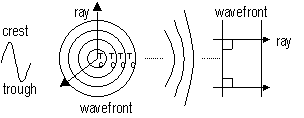WAVES
REFLECTION
Laws of reflection
-incident ray, normal & reflected ray all lie in same plane
-angle of incidence = angle of reflection
regular reflection(smooth surface) & irregular reflection
Properties of image
-same size
-upright
-virtual
-laterally inverted
-as far behind mirror as object is in front
REFRACTION
Laws of refraction
-incident ray, normal & reflected ray all lie in same plane
-for 2 given media, sin i/sin r = const
light; dense > less dense medium: refracts away from normal
light; dense > more dense medium: refracts towards normal
Refractive index, n = sin i/sin r = speed of light in medium 1/ speed of light in medium 2 = c1/c2 (from medium 1 > 2)
-depends on light colour (usually stated for yellow Na light)
1n2: n from medium 1 to medium 2 = c1/c2
if medium 1 = vacuum, 1n2 = absolute n (represented by n2)
nglass=1.5, nwater=1.33 (4/3), ndiamond=2.4, nair=1.0003(regarded as negligible)
1n2=1/2n1, 1n3 = 1n2 x 2n3
Total internal reflection
occurs when light travels from (optically) dense > (optically) less dense medium

when ∠ r = 90°, ∠ i = critical ∠ (∠ c)

if ∠ i > ∠ c: light not refracted, only reflected at boundary

at i = c, 2n1 = sin i/sin r = sin c => 1n2 = 1/sin c
Uses of TIF: -reflecting prisms (no light loss, lasts long: no silver coat to wear away), -optical fibres (endoscope, TV, tel, comp signals)


Principle of reversibility of light

if light ray AE is reversed in dirn to travel along EA, it will travel along AO n water
air n water = sin ∠ (PAE)/sin ∠ (OAQ) = (AR/AI) / (AR/AO) = AO/AI = real depth / apparent depth
(for small angles: OA → real depth, AI → apparent depth)
Wave motion

ray: lines of movement at right angles to wavefront
wavefront: lines joining particles that are in phase
crest: max upwards disp from equil pos (trough: min)
displacement: vector dist of a particle moved from rest position
amplitude: max displacement
phase difference: time difference (in radians) by which two oscillations differ from being in phase w/ each other
period: time for 1 complete oscillation
frequency: # of oscillations per unit time
wavelength: dist of 1 complete oscillation (smallest dist bet 2 pts in phase)
waves speed: speed w/ which crest (/trough) moves
Wave velocity = wavelength /time => v = λ/T => v = fλ
In SHM: total energy = ½ mω2A2
∴E ∝ A2 => intensity ∝ (amplitude)2, I =kA2
intensity: depends on energy passing through unit area in unit time
for waves (eg SHM), E associated w/ oscillation is ∝ A2
Transverse waves
-propagated by vibrations perpendicular to dirn of travel of wave
-water wave, wave of plucked string, EM waves
Longitudinal waves
-vibrations // to dirn of travel of wave
-partially displacement of particles (high density area: compressions, C + low density area: rarefractions, R)
(C & R move w/ speed of wave)
Polarisation


plane-polarised wave: a transverse wave whose particles vibrate in 1 plane only
polaroid: artificial material to causes plane-polarised light by allowing light of particular polarisation to pass
rotate 1 polaroid 90°: max bright > dark > darker > no light


Microwaves
shows T produces polarised waves => transverse waves emitted [longitudinal waves: no polarisation]


Amplitude of double polarised wave

Amplitude of initial electric vector = Eo
Amplitude of final electric vector = E = Eocosθ
intensity ∝ amplitude2 [E2 = Eo2cos2θ]
∴intensity of b, I = I ocos2θ [90°: I = 0, 0°, I = I o]
Back to 'A' level notes index
Back to notes index













